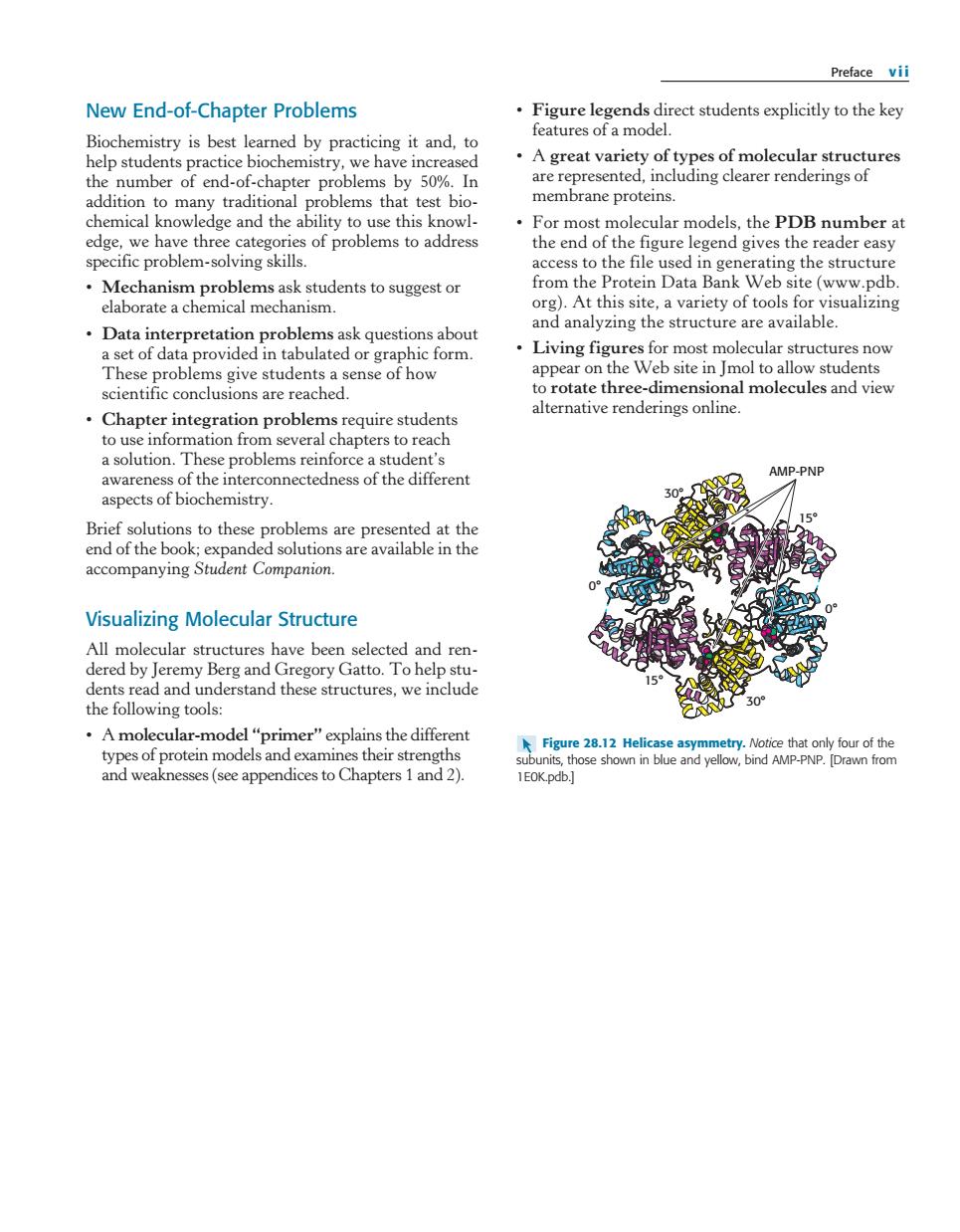正在加载图片...

Preface vii New End-of-Chapter Problems Figure legends direct students explicitly to the key features of a model. Biochemistry is best learned by practicing it and,to help students practice biochemistry,we have increased A great variety of types of molecular structures the number of end-of-chapter problems by 50%.In are represented,including clearer renderings of addition to many traditional problems that test bio- membrane proteins. chemical knowledge and the ability to use this knowl- For most molecular models,the PDB number at edge,we have three categories of problems to address the end of the figure legend gives the reader easy specific problem-solving skills access to the file used in generating the structure Mechanism problems ask students to suggest or from the Protein Data Bank Web site(www.pdb. elaborate a chemical mechanism. org).At this site,a variety of tools for visualizing Data interpretation problems ask questions about and analyzing the structure are available a set of data provided in tabulated or graphic form. Living figures for most molecular structures now These problems give students a sense of how appear on the Web site in Jmol to allow students scientific conclusions are reached to rotate three-dimensional molecules and view Chapter integration problems require students alternative renderings online. to use information from several chapters to reach a solution.These problems reinforce a student's awareness of the interconnectedness of the different AMP-PNP aspects of biochemistry. Brief solutions to these problems are presented at the end of the book;expanded solutions are available in the accompanying Student Companion. Visualizing Molecular Structure All molecular structures have been selected and ren- dered by Jeremy Berg and Gregory Gatto.To help stu- 15 dents read and understand these structures,we include the following tools: ·A molecular-model“primer'”explains the different Figure 28.12 Helicase asymmetry.Notice that only four of the types of protein models and examines their strengths subunits,those shown in blue and yellow,bind AMP-PNP.[Drawn from and weaknesses(see appendices to Chapters 1 and 2). 1EOK.pdb.]Preface vii New End-of-Chapter Problems Biochemistry is best learned by practicing it and, to help students practice biochemistry, we have increased the number of end-of-chapter problems by 50%. In addition to many traditional problems that test biochemical knowledge and the ability to use this knowledge, we have three categories of problems to address specific problem-solving skills. • Mechanism problems ask students to suggest or elaborate a chemical mechanism. • Data interpretation problems ask questions about a set of data provided in tabulated or graphic form. These problems give students a sense of how scientific conclusions are reached. • Chapter integration problems require students to use information from several chapters to reach a solution. These problems reinforce a student’s awareness of the interconnectedness of the different aspects of biochemistry. Brief solutions to these problems are presented at the end of the book; expanded solutions are available in the accompanying Student Companion. Visualizing Molecular Structure All molecular structures have been selected and rendered by Jeremy Berg and Gregory Gatto. To help students read and understand these structures, we include the following tools: • A molecular-model “primer” explains the different types of protein models and examines their strengths and weaknesses (see appendices to Chapters 1 and 2). • Figure legends direct students explicitly to the key features of a model. • A great variety of types of molecular structures are represented, including clearer renderings of membrane proteins. • For most molecular models, the PDB number at the end of the figure legend gives the reader easy access to the file used in generating the structure from the Protein Data Bank Web site (www.pdb. org). At this site, a variety of tools for visualizing and analyzing the structure are available. • Living figures for most molecular structures now appear on the Web site in Jmol to allow students to rotate three-dimensional molecules and view alternative renderings online. Figure 28.12 Helicase asymmetry. Notice that only four of the subunits, those shown in blue and yellow, bind AMP-PNP. [Drawn from 1E0K.pdb.] 0° 0° 30° 30° 15° 15° AMP-PNP